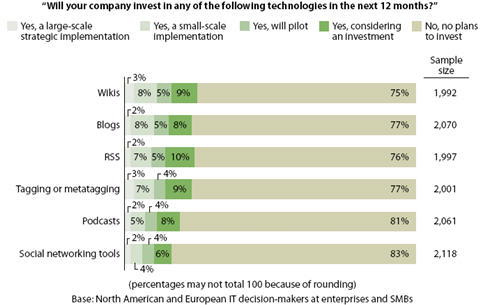2009: The year of enterprise social networks

While some companies are trying to keep Facebook and MySpace out of the office, Research In Motion co-chief executive Jim Balsillie thinks that the social networking phenomenon is coming soon to an enterprise near you. "Once social networking becomes a B2B phenomenon--not unlike IM and texting--I believe every single social-networking user will want a data plan," Balsillie said during a presentation at the GSMA Mobile World Congress.
RIM sees dollar signs in social networking, but the cash from more data plans won't flow overnight. As Enteprise 2.0 guru and Harvard Business School professor Andrew McAfee said in November 2007:
We need to keep in mind that most E2.0 tools are new, and that their acceptance depends on shifts in perspective on the part of business leaders and decision makers, shifts for which the word ‘seismic’ might not be an overstatement. Enterprise 2.0 tools have no inherent respect for organizational boundaries, hierarchies, or job titles. They facilitate self-organization and emergent rather than imposed structure. They require line managers, compliance officers, and other stewards to trust that users will not deliberately or inadvertently use them inappropriately. They require these stewards to become comfortable with collaboration environments that “practice the philosophy of making it easy to correct mistakes, rather than making it difficult to make them” as Jimmy Wales has said. They require, in short, the re-examination and often the reversal of many longstanding assumptions and practices. It is not in the least disrespectful or contemptuous of today’s managers to say that it will take them some time to get used to this.
A recent Forrester survey indicated little interesting in spending on social networking among enterprises and SMBs:

I have a feeling that social networking adoption will sneak up on companies, as IM did in the past decade, faster than Forrester's survey indicates. It will happen in pockets rather than as large scale deployments, which will happen when the large enterprise vendors that corporations like to deal with build it into their platforms. It will be driven by those "stewards" mentioned by McAfee who viscerally get the value of a social Web in business. I'll predict 2009 as the year of enterprise social networks.
Forrester's Jeremiah Owyang has some advice for managers who want to unleash the potential of social networking.
"Enterprise content management systems are already showing signs of 'social features' and modules being bolted on to their experience. Also, business groups or smaller teams are using application service providers to manage products, calendars, and to share documents with tools like Google Docs, 37 Signal products and others. Companies that limit the access of social networks within their workplace are often cutting off works from the marketplace where customers, prospects, partners, and competitors are already exchanging information. Companies should treat enterprise social networking like all other enterprise communication tools, have governance, set a process, and train and entrust employees to communicate well online as well as in the real world."